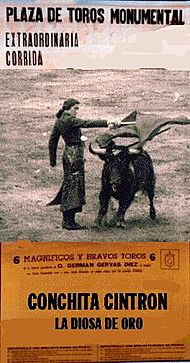Conchita Cintrón facts for kids
Quick facts for kids
Conchita Cintrón
|
|
|---|---|

Conchita entering a bullring in Segovia, Spain
|
|
| Born | August 9, 1922 Antofagasta, Chile
|
| Died | February 17, 2009 (aged 86) Lisbon, Portugal
|
| Resting place | Trajouce, Lisbon, Portugal |
| Occupation | Professional bullfighter, journalist, dog breeder |
| Years active | 1936-1950 |
| Spouse(s) | Francisco de Castelo Branco |
| Children | Six |
| Parent(s) |
|
Concepción Cintrón Verrill, known as Conchita Cintrón, was a very famous female bullfighter. People also called her La Diosa de Oro, which means 'The Golden Goddess'. She was born in Antofagasta, Chile, on August 9, 1922, and passed away in Lisbon, Portugal, on February 17, 2009. Conchita was known for her amazing grace and bravery in the bullring. Many consider her the most famous female bullfighter ever.
Contents
Early Life and Training
Conchita Cintrón was born in Chile in 1922. Her father, Francisco Cintrón Ramos, was from Puerto Rico. He was a businessman in South America. Her mother, Lola Kathleen Verrill, was American with Irish family.
When Conchita was three years old, her family moved to Lima, Peru. This is where she grew up. She learned to ride horses at a very young age. At age 11, she joined a riding school. Her teacher was Ruy da Câmara, a Portuguese rejoneador. A rejoneador is a bullfighter who fights from horseback. Câmara also became her bullfighting teacher. She first trained to be a rejoneadora, which is a common way to bullfight in Portugal.
Her Career Begins
Conchita first fought in public in Lima, Peru, in January 1936. On July 31, 1938, she made her debut as a novillera in Lima. A novillera is a bullfighter who is still learning and fighting younger bulls. This event made her a professional rejoneadora. It was very rare for a woman to achieve this.
After visiting Portugal, she was invited to perform in Mexico. She made her Mexico City debut on August 20, 1938. Even though she didn't kill her bull, the crowd loved her. News reports said she "caused pandemonium" in the stands.
In 1940, a bull named Chiclanero gored Conchita in Mexico City. She fainted and was taken to the medical area. But she refused surgery and went back into the ring. She quickly defeated the bull and then collapsed.
Fighting Around the World
From her debut in Mexico City in 1938, Conchita Cintrón became a huge star. She performed in many countries. These included Mexico, Portugal, France, Ecuador, Venezuela, Colombia, and Spanish Morocco. She even fought once in the United States. This fight was near San Francisco, but the bull was not allowed to be killed.
Conchita also fought in Spain. However, there were laws in Spain that tried to ban women from bullfighting. These laws mainly focused on the Spanish style of bullfighting. In that style, the bull is killed by a fighter on foot. But it was legal for her to fight there as a rejoneadora (from horseback). In other countries, she did fight as a matadora, which means fighting on foot.
Her popularity in Spain was enormous. Eventually, officials found ways around the laws. She sometimes fought on foot at special charity events. These events were not open to the general public. Her official presentation in Spain was in Seville on April 23, 1945.
A Dramatic Farewell
Conchita Cintrón planned for her final bullfight to be on October 18, 1950, in Jaén, Spain. She was in the ring with two famous male bullfighters. After performing on horseback, Conchita asked for permission to get off her horse and fight on foot. Permission was denied. This meant she should leave the arena. Another bullfighter was supposed to finish the fight.
But Conchita did something amazing. She got off her horse anyway. She took the other bullfighter's sword and cape. She then prepared the bull for the kill. She pretended to kill the bull by touching its shoulders with her fingers. The crowd went wild! People threw hats and red flowers into the ring.
Conchita calmly walked away from the bull. She was arrested as she left the ring. This was because she broke the law against women fighting on foot. But the audience was so upset about her arrest that the local governor pardoned her. She was released. This moment became one of the most dramatic in bullfighting history. As writer Orson Welles said, her career "ended in a single burst of glorious criminality."
During her career, Conchita Cintrón fought more than 750 bulls.
Life After Bullfighting
In 1950, Conchita married Francisco de Castelo Branco. He was a Portuguese nobleman and a nephew of her teacher, Ruy da Câmara. She moved to Portugal and became a Portuguese citizen. They had six children together.
In Portugal, Conchita focused on writing her memoirs. She also worked as a journalist for Latin American newspapers. She became very successful at breeding dogs, especially Portuguese Pointers.
Later, she took over a kennel that bred Portuguese Water Dogs. She helped make this dog breed popular in the United States.
In 1975, due to a political event in Portugal called the Carnation Revolution, her family's property was taken over. Conchita and her family had to leave Portugal. They lived in Mexico until the late 1980s.
Conchita Cintrón passed away on February 17, 2009, in Lisbon, Portugal. She was 86 years old.
Quotes
- "Her record stands as a rebuke to every man of us who has ever maintained that a woman must lose something of her femininity if she seeks to compete with men." —Orson Welles.
See also
 In Spanish: Conchita Cintrón para niños
In Spanish: Conchita Cintrón para niños
- List of female bullfighters
- List of Puerto Ricans


